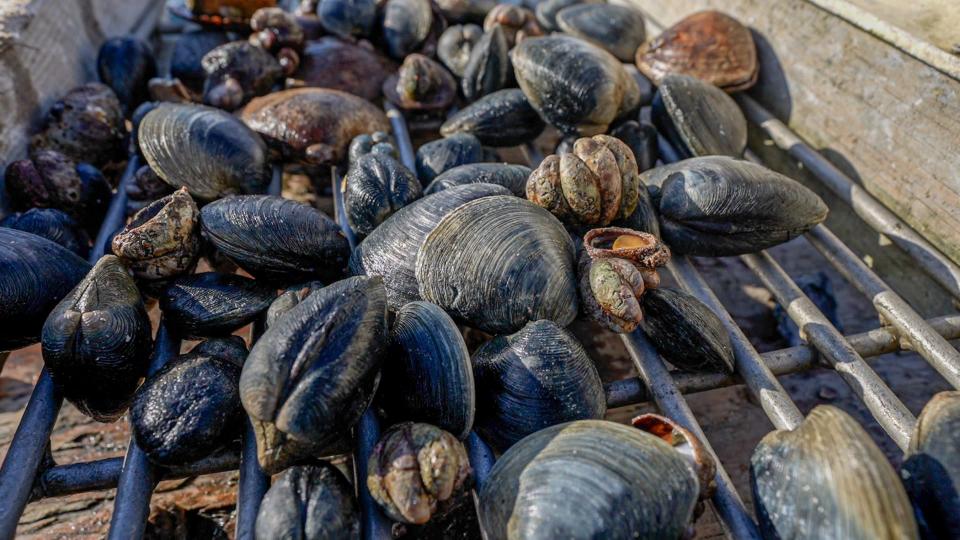Quahog commission recommends transplants and seeding the Bay − but how much will it cost?
PROVIDENCE − The final report from a legislative commission studying the decline of quahog harvests in Narragansett Bay recommends transplanting more of the hard-shelled clams from tainted areas to cleaner waters, expanding a program to seed the Bay with babies, and exploring the idea of building a shellfish hatchery to augment wild stocks.
The report does not recommend what the commercial shellfishermen who were on the commission want: changes to 20-year-old nitrogen restrictions on discharges from sewage treatment plants that they believe have led to a shortage of microscopic algae that quahogs need for food.
But the commission didn’t slam the door shut on their idea.

Report asks for study of changes on sewage treatment plant discharges
The report asks the state Department of Environmental Management “to potentially develop a plan” to modify the nitrogen cap for effluent from the three biggest treatment plants that empty into the Upper Bay, one in Providence and the other two in East Providence.
Planning would begin later this year or next and include input from the plant operators, regulators at the DEM, shellfishermen and scientists.
“I didn’t feel confident that we should have legislated it at this point,” said Rep. Joseph Solomon, the Warwick Democrat who co-chaired the commission. “What was clear was that more study was needed.”
James Boyd, one of four quahoggers who sat on the commission, said the report has a lot of positives for the shellfish industry, including the study on nitrogen releases.
“Without the data, they can’t justify doing it,” said Boyd, a board member of the Rhode Island Shellfisherman’s Association. “We’ll see what happens.”
Report follows nine months of work by scientists, regulators and quahoggers
The report's contents come as no surprise. Over eight hearings that began last September and wrapped up a month ago, the 13 members of the commission were unable to reach consensus on the impact of the wastewater treatment regulations that were enacted after a historic fish kill in Greenwich Bay in 2003.
While the shellfishermen all argued that the nitrogen reductions had caused a drop-off in phytoplankton production that has left quahogs without enough food to filter out of the water, marine scientists, state officials and environmental advocates said their contention lacked iron-clad evidence.
The doubters contended that warming winters and other climate change impacts are also responsible for the changes in plankton growth in New England's largest estuary, and that loosening nitrogen rules could start to reverse recent improvements in water quality.
The report describes the Bay ecosystem as "highly complex and multifaceted" and says there are many potential reasons for the reduced quahog harvest.
But it also lends credence to the notion that nitrogen reductions are playing a role in the trend in catches, which dropped 56% between 2012 and 2022, saying the two "may be more closely correlated" rather than "a coincidental decline."
Aim of raising nitrogen levels is to increase food supply for quahogs
The shellfishermen are pushing to raise the cap on nitrogen discharges in the winter, an idea that was first put forward by University of Rhode Island oceanographer Candace Oviatt, a foremost expert on Narragansett Bay.
Nitrogen is the key ingredient in fertilizer, and it acts in the water just as it does on land by feeding the growth of plant life. Shellfishermen say that by strategically increasing nitrogen flows from the treatment facilities in winter, quahogs would have more food to eat when they need it most, and their numbers would increase as a result.
The change would be limited to the cold-weather months only. The cap would be lowered again in time for summer, when the threat increases for uncontrolled algae growth, which can lead to large blooms that deplete oxygen levels in the water, creating the types of conditions that can cause fish kills.
But there is concern about unwanted consequences
While adjusting nitrogen levels sounds straightforward, the proposal has met with skepticism from treatment plant operators, who say that it wouldn’t be easy to modify the biological process that break down nitrogen compounds produced by human waste.
The DEM has also resisted modifying nitrogen levels out of fear of hypoxia. Oxygen levels in the Bay have improved, but they still aren’t meeting standards in all areas, according to the agency.
When asked about the request in the report to look at adjusting the nitrogen cap, Amanda Cantrell, a spokeswoman for the DEM, said the agency will remain open-minded but has no immediate plans to make changes.
“Instead, RIDEM will focus its efforts on the other recommendations in the report, including, but not limited to, seeking funding for a sustained quahog seeding and transplant program and establishing additional spawner sanctuaries,” said Cantrell, chief of staff at the agency. “DEM will evaluate potential changes to the WWTFs’ nitrogen limits in accordance with EPA requirements of the federal Clean Water Act when these permits are reissued.”
Stakeholders plan to continue to work together
Solomon said that while there isn’t money in the current budget proposal to expand transplants or seeding, he hopes to secure funding next year.
In the meantime, he’s asked stakeholders to come up with estimates for what those efforts would cost. He also said he’ll consider legislation in the next General Assembly session to create a permanent quahog advisory board, another recommendation in the report.
“I'm proud of the work of the commission members,” he said. “I think getting everyone in a room together showed how much progress can be made. We’re going to push for more coordination going forward.”
This article originally appeared on The Providence Journal: Quahog commission recommends seeding, transplants; seeks nitrogen data

